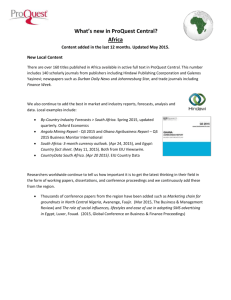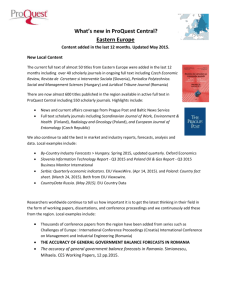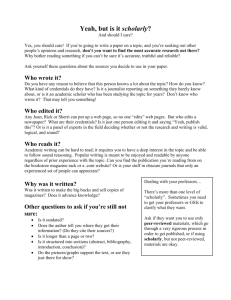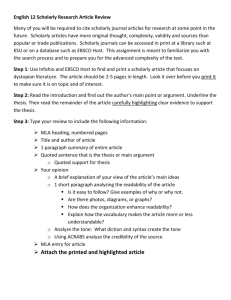Scholarly Journal Guide
advertisement
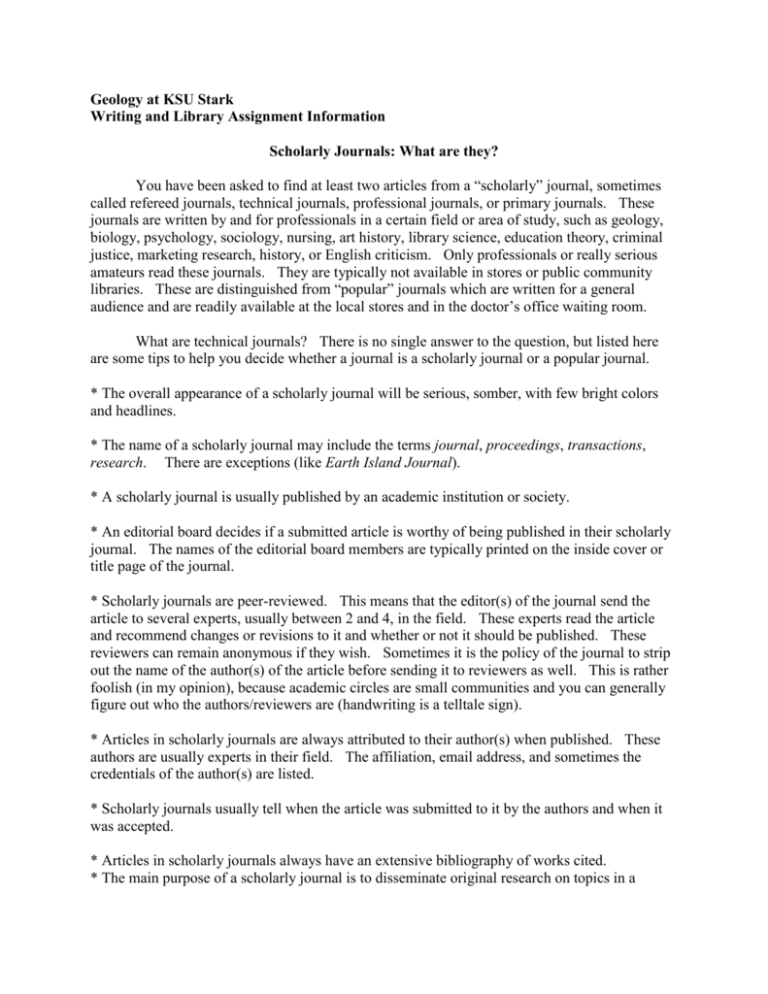
Geology at KSU Stark Writing and Library Assignment Information Scholarly Journals: What are they? You have been asked to find at least two articles from a “scholarly” journal, sometimes called refereed journals, technical journals, professional journals, or primary journals. These journals are written by and for professionals in a certain field or area of study, such as geology, biology, psychology, sociology, nursing, art history, library science, education theory, criminal justice, marketing research, history, or English criticism. Only professionals or really serious amateurs read these journals. They are typically not available in stores or public community libraries. These are distinguished from “popular” journals which are written for a general audience and are readily available at the local stores and in the doctor’s office waiting room. What are technical journals? There is no single answer to the question, but listed here are some tips to help you decide whether a journal is a scholarly journal or a popular journal. * The overall appearance of a scholarly journal will be serious, somber, with few bright colors and headlines. * The name of a scholarly journal may include the terms journal, proceedings, transactions, research. There are exceptions (like Earth Island Journal). * A scholarly journal is usually published by an academic institution or society. * An editorial board decides if a submitted article is worthy of being published in their scholarly journal. The names of the editorial board members are typically printed on the inside cover or title page of the journal. * Scholarly journals are peer-reviewed. This means that the editor(s) of the journal send the article to several experts, usually between 2 and 4, in the field. These experts read the article and recommend changes or revisions to it and whether or not it should be published. These reviewers can remain anonymous if they wish. Sometimes it is the policy of the journal to strip out the name of the author(s) of the article before sending it to reviewers as well. This is rather foolish (in my opinion), because academic circles are small communities and you can generally figure out who the authors/reviewers are (handwriting is a telltale sign). * Articles in scholarly journals are always attributed to their author(s) when published. These authors are usually experts in their field. The affiliation, email address, and sometimes the credentials of the author(s) are listed. * Scholarly journals usually tell when the article was submitted to it by the authors and when it was accepted. * Articles in scholarly journals always have an extensive bibliography of works cited. * The main purpose of a scholarly journal is to disseminate original research on topics in a specific field. Thus, the Journal of Paleontology publishes original articles on paleontological research. * Most articles in a scholarly journal have an Abstract at the beginning, which is a short summary of the article. This abstract is often cataloged in search engines like Biological Abstracts and GeoRef. * Scholarly journals are often published monthly, bimonthly, quarterly, or annually; usually, they are not weekly (Science and Nature are notable exceptions). * There are few to no advertisements in scholarly journals. * The vocabulary and writing style in a scholarly journal is typically technical and at a high level. * Generally, you must use a specialized index to find scholarly journal articles. * There are typically few pictures, many graphs and charts, and mostly text in scholarly journal articles. * There are few to no quotes or interviews in a scholarly journal article. * Scholarly journals are typically housed only in university libraries, libraries of research institutions like Woods Hole Oceanographic Institute, and museum libraries. Telltale Signs That You Are Looking at a Popular Journal * The overall appearance is brightly colored, with headlines, and probably with photos on the cover (i.e. an environmentalist posing with a manatee, a cool Hubble telescope shot, etc.). * The journal has the word news, review, or weekly in the title. * The publisher is a news organization, media conglomerate, or commercial press (i.e., profit-oriented). * Articles are not peer-reviewed. * Articles are written by journalists who are not experts in the field (although they may be excellent journalists). * There is no, or a very short, bibliography. * The articles are news summaries, summaries of recent advances are about current events or general interest themes. * The author may not be listed. * The vocabulary and writing style is generally at a high school level or lower; this may not be true of some more specialized popular journals like Scientific American. * Public community libraries, Borders, Wal-Mart, and other stores will carry this journal. * Many pictures will be used, almost exclusively in color. * Interviews and quotes will be used extensively. * These types of journals are usually published weekly or monthly. * There will be numerous advertisements, either dispersed throughout the journal, or placed at the beginning and/or end of the issue as in National Geographic. Confusing and Problematic Articles and Journals * Sometimes, scholarly journals publish letters, rebuttals to letters, book reviews, commentaries, or opinion pieces. These DO NOT count as scholarly articles, even though they are in a scholarly journal. * Science News, New Scientist, Earth Island Journal, and The Economist, all sound like scholarly journal titles. However, these are NOT scholarly journals. * Natural History is published by the American Museum of Natural History in New York City; however, it is NOT a scholarly journal. A Word About Gale Research sources . . . * Anything taken from a source called DISCovering Science, Gale Research or DISCovering US History, Gale Research or in fact, ANYTHING from Gale Research counts as a reference item. These are NOT journal articles of any kind! Examples of Scholarly Journals This list is by no means intended to be complete. It is merely to help you in determining what type of journal you are using. Science Nature Geology Journal of Paleontology Marine Ecology Ecology Evolution AAPG Bulletin Journal of Geology Marine Environmental Research Journal of Sedimentary Research Journal of Experimental Marine Biology and Ecology Journal of Geodynamics Island Arc Applied Geochemistry Palaios Molecular Ecology Geobios Earth and Planetary Science Letters Palaeontology Journal of Archaeological Science Journal of Mammalogy Lethaia Journal of Vertebrate Paleontology Paleobiology Geomorphology Journal of Natural History American Journal of Botany Chemical Geology Journal of Volcanology and Geothermal Research Journal of Structural Geology Palaeogeograohy, Palaeoclimatology, Palaeoecology (Tri-Paleo) Review of Palaeobotany and Palynology Archaeology Tertiary Research American Journal of Science Web Journals Nearly all web-based journals are popular journals. The only exceptions are those in which the website EXPLICITLY states that the articles are peer-reviewed and archived so that they will be available to future generations. Paleontographica Electronica is an example; it has some peer-reviewed articles, but beware: not all of the articles are peer-reviewed. Science News Journals There are several journals, usually weeklies, that summarize science news. They are written for the science professional. However, they are not original research so their articles DO NOT count as scholarly articles. The Scientist Life Science Weekly Journals of Scientific Interest New ScientistExamples of Popular Scientific American American Scientist National Geographic Discover Natural History Smithsonian National Wildlife International Wildlife Earth Island Journal Whole Earth Time Newsweek US News and World Report The Economist Nation Audobon Sierra The Mother Earth News Earthwatch Institute Journal On Earth Earth Environment Christian Science Monitor Many of these are on the web only. Bibliography www.unf.edu/library/guides/refereedarticle.html www.swcc.cc.ia.us/iowacc/library/scholarlyjournal.htm www.crk.umn.edu/library/links/profjls.htm www.lib.uoguelpg.ca/LibEd/journal-types.htm www.db.mctc.mnscu.edu/Library/tutorials


